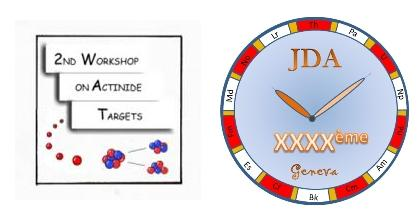Speaker
Mr
Arnaud Soudé
(Université Rennes 1)
Description
The recent discovery of the coexistence of ferromagnetic order and pressure induced superconductivity in UCoGe [1] has boosted up explorative investigations on the crystal-chemistry and low-temperature physical properties of novel intermetallic phases in the U-Co-Ge ternary system. These efforts resulted in the characterization of six intermediate phases, which have hitherto been reported in the literature, namely: UCoGe [2], UCo2Ge2 [3], UCo6Ge6 [4], U3Co2Ge7 [5], U3Co4Ge7 [6] and U2Co17 yGey with 1.3 ≤ y ≤ 3 [7].
Our systematic study on the U-Co-Ge system was carried out in the whole concentration range of the ternary phase diagram. The syntheses were performed by melting appropriate amounts of the elements in an arc furnace under high-purity argon atmosphere. The samples were annealed at 973 K for 3 weeks in sealed silica tubes, followed by air quenching down to room temperature. The products were characterized by powder X ray diffraction. The microstructure and the chemical compositions were studied on polished surfaces using a scanning electron microscope coupled with an energy dispersive spectrometer (SEM-EDS). The crystal structures were determined from single crystal X-ray diffraction data. DC magnetic measurements were carried out using a SQUID magnetometer. The electrical resistivity was measured employing a standard DC four-point technique.
The assessment of U-Co-Ge isothermal section at 973 K confirmed the formation of the previously reported compounds. However, the crystal structure of UCo6Ge6 was found different from that reported in the literature. In addition, our study revealed the existence of as many as twelve novel compounds: UCo3 yGey with 0.2 ≤ y ≤ 0.4, UCo4.5Ge0.5, U2Co3Ge, U3Co6Ge2, U3Co12 xGe4 with 0.0 ≤ x ≤ 2.0 [8], ~U15Co55Ge30, U6Co30Ge19, U34Co4 xGe33 with 0.0 ≤ x ≤ 3.0, UCo1-yGe1+y with 0.6 ≤ y ≤ 0.7, ~UCoGe2, U4Co1-yGe6-x+y with x = 0.6 and 0.0 ≤ y ≤ 0.5 and UCo1 xGe2 with 0.22 ≤ x ≤ 0.45 [9,10]. In this communication we describe the crystallographic features as well as the magnetic and electrical transport properties of U4Co1 yGe6-x+y and UCo1-yGe1+y.
UCo1-yGe1+y (0.6 ≤ y ≤ 0.7) crystallizes with a unit cell related to the AlB2 type with the lattice parameters a = 4.111(5) Å and c = 7.641(5) Å (fig. 1a). The structure is composed of [U6] trigonal prisms, alternatively centred either by the (Co,Ge) atoms or the Ge atoms. The presence of modulations in the crystal structure makes its refinement difficult. The magnetic measurements revealed a ferromagnetic transition (fig. 2a), at the Curie temperature varying along the homogeneity range (38 K ≤ Tc ≤ 48 K). In the paramagnetic region, the magnetic susceptibility follows a modified Curie-Weiss law with the effective magnetic moment of 2.40(1) µB/(U atom). The electrical resistivity of UCo1-yGe1+y is about 360 µcm at room temperature and shows rather minor temperature variation (fig. 2b). Below 75 K, it slightly increases with decreasing temperature reaching 375 µcm at liquid helium temperature. The ferromagnetic phase transition is hardly resolvable from the resistivity curve.
Fig.1: Projections on the (a,b) plane of the crystal structures of a) UCo1-yGe1+y and b) U4Co1-yGe6-x+y
U4Co1-yGe6-x+y (x = 0.6 and 0.0 ≤ y ≤ 0.5) adopts the hexagonal Er4(Ga,Ge)7 type structure (space group P m2) with the lattice parameters a = 8.016(1) Å and c = 4.021(1) Å. This crystal structure is a derivative of the AlB2 type. The U atoms form [U6] trigonal prisms. Six over eight of them are occupied by the Ge atoms, one is centred by the Co atom and the eighth prism is empty, due to the proximity of two Ge atoms that are strongly shifted from the center of their prisms (fig. 1b). The compound shows a ferromagnetic transition at Tc = 39 K (fig. 2a). At higher temperatures a modified Curie-Weiss law is observed for the magnetic susceptibility, with the effective magnetic moment of 2.76(4) µB/(U atom). In the paramagnetic state the resistivity is almost temperature independent being of about 275 µcm (fig. 2b). The magnetic transition manifests itself as a distinct kink at the resistivity curve, below which the resistivity sharply decreases down to 175 µcm at 4 K.
Fig.2: Temperature dependencies of (a) the magnetization and (b) the resistivity of U4Co1-yGe6-x+y (blue symbols) and UCo1-yGe1+y (red symbols). The ferromagnetic phase transitions are marked by arrows.
References
[1] N. T. Huy et al., Phys. Rev. Lett. 99 (2007) 067006
[2] R.Troć, V.H. Tran, J. Magn. Magn. Mater. 73 (1988)389-397
[3] T. Endstra et al., J. Appl. Phys. 69(8) (1994) 4816-4818
[4] W. Buchholz, H.U. Schuster, Z. Anorg. Allg. Chem. 482 (1981) 40-48
[5] S. Bobev et al., J. Solid State Chem. 180 (2007) 2830-2837
[6] R. Pöttgen et al. , J. Solid State Chem. 115 (1995) 247-254
[7] B. Chevalier et al., J. Alloy Compd. 233 (1996) 174-182
[8] A. Soudé et al., J. Solid State Chem., submited
[9] A.Soudé et al., Book of Abstracts, 38ème Journées des Actinides, Wroclaw, Poland, 2008, p.109
[10] A.Soudé et al., Book of Abstracts, 39ème Journées des Actinides, La Grande Motte, France, 2009, p.57-58
Primary author
Mr
Arnaud Soudé
(Université Rennes 1)
Co-authors
Dr
Dariusz Kaczorowski
(INTiBS)
Dr
Henri Noël
(Université Rennes 1)
Dr
Mathieu Pasturel
(Université Rennes 1)
Dr
Olivier Tougait
(Université Rennes 1)
